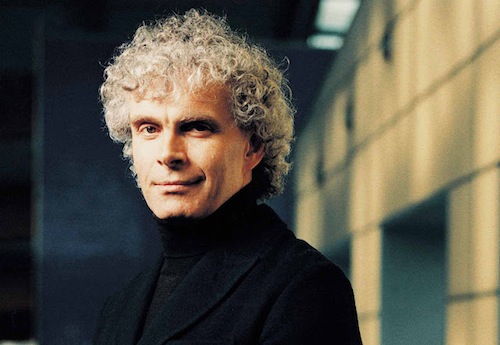Berlin Phil’s Schumann takes a while to get in gear

Simon Rattle conducted the Berlin Philharmonic Orchestra in Schumann’s Symphonies Nos. 1 and 2 Sunday night at Carnegie Hall.
Fair or not, expectations are a little different for the big-name European Orchestras, and it may have been due to that higher bar that the Berlin Philharmonic Orchestra’s Sunday night concert at Carnegie Hall, the first of two installments in a Schumann cycle, felt strangely unsatisfying. When you think of Simon Rattle and the BPO, you expect tight playing, focus, discipline—everything is supposed to be in its place. This is not what we got on Sunday night, at least not for the first forty minutes.
Schumann’s “Spring” Symphony, which opened the program, felt at times like a warm-up. Its beginning was bright, almost too bright, sounding more aggressive than assertive. Then, moving into the allegro, it felt lost—not just in the sense that the musicians weren’t playing together (though that was certainly the case, too), but in that the picture never came into focus. Ensemble was slightly off, and dynamic and articulatory decisions were not clearly executed, resulting in a constant state of blurriness—the BPO’s playing never felt crisp enough to sustain the music’s sunny energy.
During the “latecomers’ pause” after the first movement, Rattle actually stepped off the podium to deliver what looked like a pep talk to his troops. Improved results were not immediately apparent—velvet warmth from the strings notwithstanding, the Larghetto never quite felt settled, again suffering from a lack of organization.
The Scherzo likewise showed plenty of muscle but less coordination, and the finale was sleepy, the music’s feeling of ease replaced by a sense of very slight confusion. There was no direction, no sense of where we were in the trajectory of the piece.
Whatever Rattle said to his players from the stage, his intermission speech must have made a bigger impression, as Symphony No. 2 was a different story. Here, the orchestra’s parts were all in working order, resulting in a captivating performance right from the introduction, transforming brilliantly from soothing to stormy. It seems like such a basic thing, but when everything is together, the energy of the music is naturally amplified. The musicians sound unified in purpose, and their common direction becomes all the clearer.
The Scherzo retained that focus, lending natural ease to the tittering of the strings and allowing for a luminous sound in the flowing trio sections. Suddenly, the BPO truly seemed to be a finely-tuned instrument in Rattle’s hands.
The finale was perhaps the most finely crafted movement of the four, showing superior attention to detail. The bounding motif that dominates the exposition was stirring, and precisely articulated—it had a booming sound that shook the floor of the auditorium, yet felt more playful than forceful. Precision, too, characterized the playing of the violins, who dispatched their flowing slurred runs with effortless liquidity. This was clockwork playing, and it was marvelous to hear.
But the poignant Adagio stood out as the jewel of the performance, broad and singing, and showing off the Berlin strings at their wailing, incandescent best. The sheer intensity of sound was hair-raising at times, and Rattle put it to good effect. His pacing was generous, allowing the music to have its full breadth, and bringing the soaring, romantic swells almost to Hollywood heights.
The Berlin Philharmonic’s Schumann cycle concludes Monday at Carnegie Hall with Symphonies Nos. 3 and 4, as well as the U.S. premiere of Georg Friedrich Haas’s dark dreams. carnegiehall.org







Posted Oct 07, 2014 at 1:35 pm by Dave
What is your impression of their recently recorded Schumann album? I’m rather surprised to hear such critical comments directed at the Spring Symphony. Was it the performance itself or Rattle’s interpretation that bothered you the most?